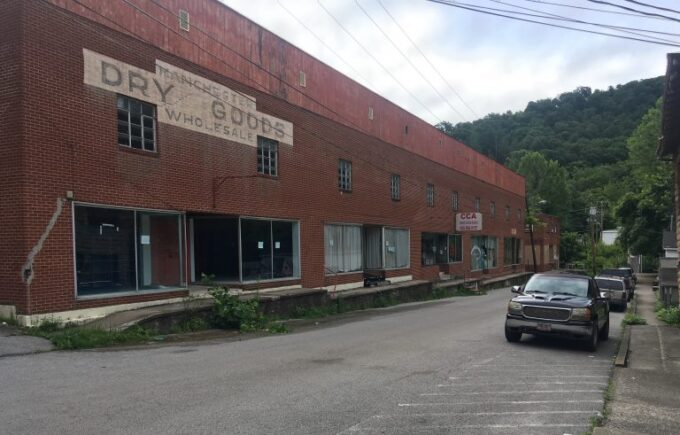Disinvestment in rural Kentucky leaves ‘nothing to do’ but drugs

This is part of a series of stories from the field for the “Understanding Communities of Deep Disadvantage” project.
By Liv Mann
CLAY COUNTY, Ky. — Everywhere we went in Clay County, people told us about drugs. Pill mills, meth labs, addictions and overdoses are part of life there, so much so that almost everyone we met had a story about drug use — their own, a parent’s, a partner’s, a child’s.
Most people had their own suggestions about what needed to be done, and many tapped into various veins of national drug discourse.
Clay County is tucked away among the rolling mountains of eastern Kentucky. It’s home to just over 20,000 people, but fewer than 1,400 live in the county seat, Manchester. The rest of the population is strewn throughout the county in towns like Oneida or tucked back in hollers with steep green sides and rushing creeks that threaten to wash out roads and low-water bridges. Almost everyone is white. About 38.6% of households in the county are living in poverty, and 36.5% get food stamps.
Complicating these economic challenges are an enduring local drug crisis, prevalent medical problems like cancer and diabetes, and a lack of intergenerational mobility. Combined, these factors make Clay County one of the most disadvantaged counties in America.
To learn more about what this means for the people who live, survive, and thrive there, we spent three months in the summer of 2019 interviewing community leaders and members in the county’s halls, historical societies, businesses, coffee shops, trailers and houses.
Multi-faceted drug epidemic
Some Clay County residents focused on the medical side of the pain pill problem. Aurora, a mother and grandmother volunteering at a clothes closet, insisted that doctors’ prescribing practices needed regulation.
She offered up her husband’s story as an example. Phil was injured and disabled at work, and he subsequently developed an addiction to pain pills. His addiction is enabled by his family, many of whom also have drug addictions, but Aurora placed additional blame on Phil’s doctor.
Even though the doctor knew about Phil’s struggle with addiction, Aurora explained, “she started him on a Norco 10 and Gabapentin, Neurontin!” How do we solve the drug problem, then? “Stop making it so easy to get!”
Other community members favored a law-and-order approach.
“Like, the people who are dealing,” explained Stephen, a young single mother of three. “They [law enforcement] need to start there and work their way down. I think they need to start there and then work their way down with the people who are going to buy, and actually have some form of consequence instead of just putting you in there [jail] and just sending you out.”
Still others talked about jobs as the solution to the problem, telling a story about how the stress of economic decline feeds and fuels drug addictions.
But there was one set of claims that stood out, in part because of its disconnect from the popular national discourses surrounding the drug crisis. It wasn’t part of a national story. It was a distinctly local one: there’s just nothing to do but drugs.
‘Nothing around here to do’
Travis is a recovering meth addict who can’t find a job. His unemployment isn’t unusual — the labor force participation rate in Clay County is only 37.6% — but because of it, he has to sell his suboxone treatment on the local black market to pay rent each month. He isn’t fond of Clay County, and he doesn’t have fond memories of growing up there. As he told it, the Walmart parking lot was the only place he had to hang out with friends.
“There wasn’t nothing to do. There ain’t nothing around here to do,” he said, slouched back in his chair tucked in one corner of a hot trailer with holes in the floor. “That’s the big flaw around here. That’s why I think everybody turns to drugs around here.”
We heard the same thing over and over: There’s nothing to do in Manchester. There’s nothing to do in Clay County.
The roller rink closed down, the movie theater became a Pentecostal church, and all the stores left. Even the public park is gone, bulldozed over for construction of a new road. And Travis wasn’t the only one to link these changes to the drug crisis. Teachers, mothers, grandmothers and drug dealers all told us the same story.
Public spaces and community cohesion
Bringing back a movie theater or a playground seems unlikely to make a difference in an entrenched drug epidemic. Yet the erasure of public spaces has serious consequences. The kinds of places that Clay County has lost are essential to building community.
Movie theaters, roller rinks, and public parks are part of what sociologist Eric Klinenberg calls social infrastructure: “the physical places and organizations that shape the way people interact.” When social infrastructure is strong and stable, people form bonds and communities are strengthened. Yet when social infrastructure is lacking, opportunities to build these bonds are limited and isolation grows.
So while the loss of a public park may not by itself cause a wave of teenagers to turn to drugs, its absence denies youth a protective factor — community bonds — that might prevent them from turning to drugs in the first place.
On the other hand, a mother who can take her children to a public park and meet other mothers there will have that many more protective factors on her side when it comes to avoiding or stopping drug use. She has that many more opportunities to learn about resources available to her, from health department programs to educational opportunities. She, her children, and others like them can become more fully a part of their community because of a simple public park.
In Clay County, however, the decay of social infrastructure eats away at community cohesion, creating fertile ground for an enduring drug epidemic.
Local solutions
Community-level mechanisms like this usually receive too little attention in the national drug discourse. Academics and journalists have long focused on debating macro-level causes of the drug epidemic afflicting places like Clay County: economy-induced despair, regional culture, or shifts in medical marketing.
But these national stories trickle down to people’s lives through local experiences. Aurora understands the medical side of the drug crisis through her husband’s history with his local doctor. Stephen argues the need for tougher drug law enforcement because of the flaws she’s seen in the local justice system. And Travis sees the economic decline of places like Clay County in the way local social infrastructure has crumbled.
Outside of Clay County, activists, policymakers and researchers have pointed out the links between disinvestment in communities of color and urban drug epidemics, calling for solutions that involve reinvestment in the social infrastructure of neighborhoods communities.
When it comes to the rural drug crisis, we should learn from these past calls to action and from people like Aurora, Stephen and Travis. We should begin looking for community-level opportunities for intervention.
If decaying social infrastructure can serve to retrench drug epidemics, it’s time to ask ourselves if we should try funding parks and public spaces the way we fund drug treatment centers. Or, where social infrastructure remains stable, we should explore the opportunities for intervention it offers. An information board at a local park could advertise local treatment options. Fliers in the bathroom stalls at a movie theater could direct people to the local needle exchange.
These are small changes, and highly focused interventions, but they’re local. And local matters in the rural drug epidemic.
 Liv Mann is a second-year Ph.D. student in sociology and social policy at Princeton University. Her research focuses on the intersections of criminal justice and welfare systems. More broadly, she is interested in the relationships between economic conditions and crime and the ways social safety nets affect America’s most vulnerable. In the summer of 2019, she was embedded in Clay County, Kentucky. Prior to coming to Princeton, she received her undergraduate degree in sociology and criminal justice from the University of South Dakota.
Liv Mann is a second-year Ph.D. student in sociology and social policy at Princeton University. Her research focuses on the intersections of criminal justice and welfare systems. More broadly, she is interested in the relationships between economic conditions and crime and the ways social safety nets affect America’s most vulnerable. In the summer of 2019, she was embedded in Clay County, Kentucky. Prior to coming to Princeton, she received her undergraduate degree in sociology and criminal justice from the University of South Dakota.
Related reading
Hometown heroes hold up social safety net in rural Kentucky
Moving the needle on syringe exchanges in Appalachian Kentucky
Flood recovery out of reach in rural South Carolina
Murky homeownership status derails flood relief in South Carolina
